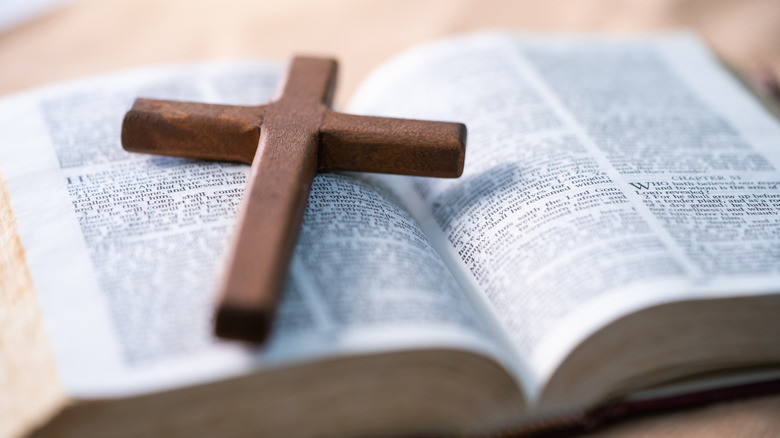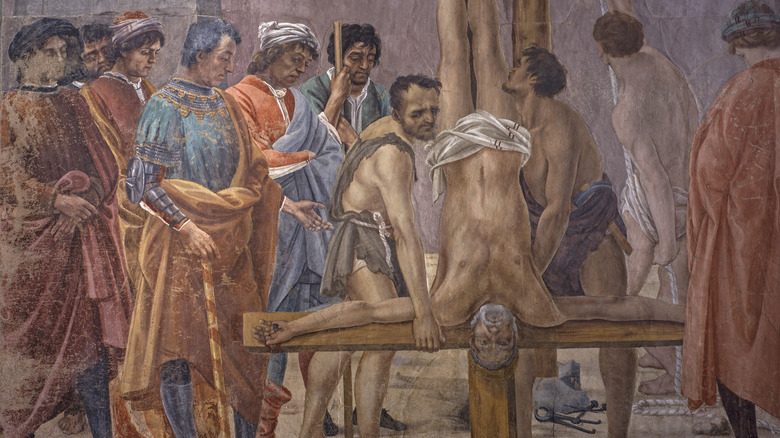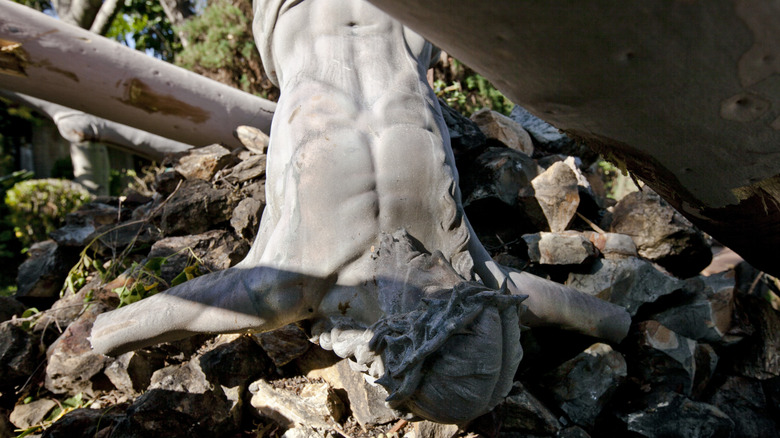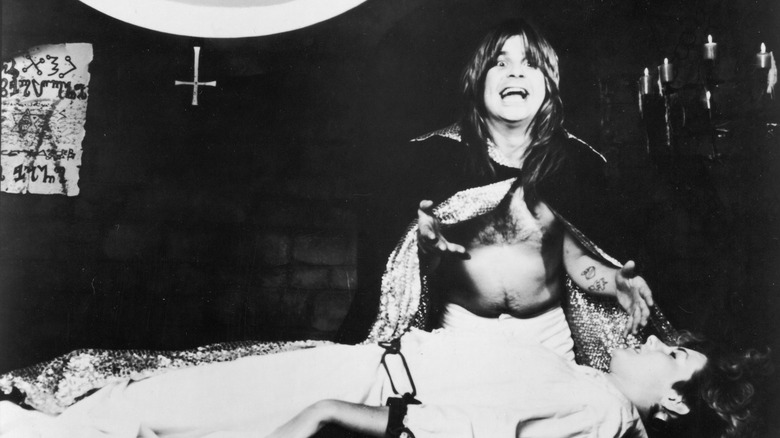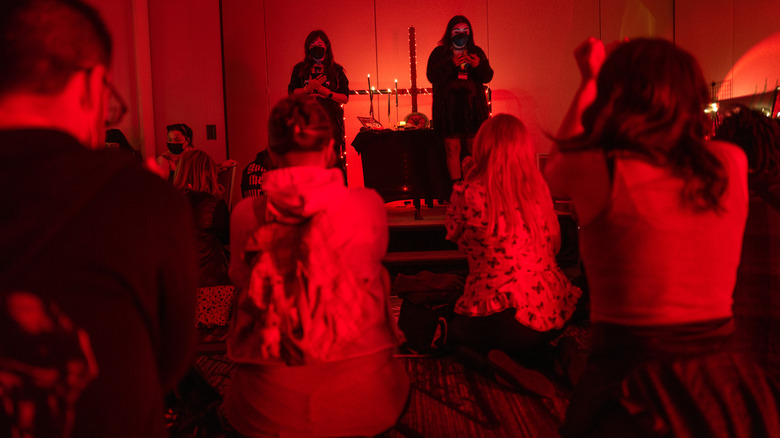What Is The Meaning Behind An Upside-Down Cross?
So we all know what an upside-down cross means, right? It gets worn on the necks of folks at black metal concerts who raise the devil horns for selfies, maybe gets tattooed on the arm of a rebellious teen tired of "the rules," and is generally an icky occult symbol used for all sorts of nefarious magical conjurations and communiqués with insidious entities. That's a good summary, right? Oh also: Before all that stuff, it symbolized the martyrdom of St. Peter at the hands of the Roman Emperor Nero in 64 C.E. So, it was a holy symbol for about ... 1,800 years.
Yes, for most of post-Jesus history, an upside-down cross meant one thing: St. Peter's execution. As the tale goes, Nero — who wasn't all that stable and had a twisted history — launched a persecution of early Christians in the Roman Empire following the Great Fire of Rome in 64 C.E. Some historians say that Christian writers embellished Nero's actions to further their own ends. Others say he embarked on a true pogrom. Either way, when Peter was crucified, he insisted that he be executed upside-down because he wasn't worthy to die like Christ. That's the traditional story.
It took until the 19th century for French Gnostic Eugène Vintras to use an upside-down cross to snub the Catholic Church. He'd been condemned by the institution for claiming to be the reincarnation of Elijah, amongst other things. Cultural uses of upside-down crosses snowballed from there. Ultimately, an upside-down cross is a reflection of the person who uses or sees it. Otherwise, it's just an upside-down object.
St. Peter's upside-down crucifixion
To be clear, historians — Christian and non-Christian alike — aren't 100% certain that St. Peter was crucified upside-down. It's more of a long-held Christian legend than a documented event. But to avoid wading into the doctrinal weeds (which is not the point of this article), let's just say Peter was crucified upside-down, as Christian tradition is concerned. And for a long, long time, an upside-down cross meant one thing: Peter's noble, righteous sacrifice in the name of God.
As the Bible study site Got Questions says, an upside-down cross is traditionally called the "Cross of St. Peter," or the "Petrine cross." And because St. Peter is considered by the Catholic Church to be the first pope — chosen by Jesus to be the inheritor of his mission on Earth — the Cross of St. Peter is especially linked to the pope. As the famous Matthew 16 verse reads: "And I tell you that you are Peter, and on this rock I will build my church ... I will give you the keys of the kingdom of heaven." This is why if Peter shows up in Christian artwork (see above), he's not only upside-down, but there are often keys nearby.
It's true that people going back to Arnulf of Reims in 991 C.E. took issue with the prince-like, earthly power of the pope and likened him to the Antichrist. This sentiment, however, doesn't seem to have played a part in connecting the upside-down cross — a symbol of St. Peter and the pope — to Satanism.
A 19th-century snub against the church
An upside-down cross meant the Cross of St. Peter until we get to obscure French occultist Eugène Vintras (1807 to 1875), who was something of an eccentric character even by 19th-century occult standards. The period of time overlapped with the Industrial Revolution and reign of Queen Victoria, and it saw a surge of interest in all things mystical (there is a somewhat complicated explanation for this Victorian-era occult obsession). Vintras formed a cult where he purportedly performed miracles, called himself the biblical Elijah, and gained something of a following in Paris. In 1846, rumors regarding the author coalesced in a pamphlet, "The Saints of Tilly-sur-Seulle," which accused him of "homosexuality, conducting Black Masses in the nude, and masturbating at the altar," per History Answers.
The pope condemned Vintras, and in response, Vintras started wearing the Cross of St. Peter around his neck. To him and his followers, it meant the passing of one era, the "Reign of Suffering," to a new era, the "Reign of Love." This is all it took for another highly influential occultist, Eliphas Levi (1810 to 1875) to take notice. In his 1886 book, "The Mysteries of Magic," he wrote about "miracles" occurring at Vintras ceremonies. These included "thousands of Hosts appear on altars where there were none; wine rises in empty chalice," blood seeping from hosts, and more. Levi was also notably the man who granted us the popular image of Baphomet (one of the many disturbing details about the figure).
Taking inspiration from such talk and operating in those same Parisian circles, writer J.K. Huysmans wrote "Là-bas" in 1891. The novel featured an infamous "black mass" scene containing an upside-down cross worn at a sacrilegious mass/orgy. From then on, the meaning of an upside-down cross — like the cross itself — got inverted to mean "Satan."
Countercultural image, especially in music
We all know what an upside-down cross means nowadays, right? Plenty of modern musicians and bands — often metal — like Ozzy Osborne, Slayer, Behemoth, Gorgoroth, Cradle of Filth, Deicide, Possessed, etc., incorporate upside-down crosses into their imagery, costumes, stage sets, and so forth. While it's not incorrect to say that all such uses share the same general meaning of disdain for the authoritarianism of traditional religion, each use contains specifics exclusive to the user. Speaking of upside-down crosses, Behemoth bassist Orion told Chelf Chelfdom, "Breaking the rules, provoking, going against the current is exciting ... It is what it is, take it or leave it."
Sometimes the use of an upside-down cross is nothing more than a clever marketing ploy to do exactly that: Provoke and get attention. This was actually the case with Black Sabbath back in the day. They weren't really comfortable with using an upside-down cross, and given that they were once cursed by Satanists, it's understandable. "I think there were some wise guys, who deliberately put that together as a ploy — as an advertising, promotional ploy, or who had seriously misgauged us as a band," former Sabbath drummer Bill Ward told Banger TV in 2010 (via Classic Rock).
It's difficult to find the precise connective tissue between such modern uses of upside-down crosses and 19th-century French occultism, aside from a general lineage of meaning. But today, upside-down crosses can be found everywhere: In loads of artwork on and offline, in anime, in tattoos, jewelry, belt buckles, backpack patches — you name it. To some, it means defiance. To others, it just looks cool.
Adopted symbol of various Satanic groups
At present, the upside-down cross has been co-opted by various groups like the Satanic Temple. Placed behind an altar during gatherings and often glowing neon, the upside-down cross represents what Satan represents to the temple: "a metaphor for questioning authority, and grounding your beliefs in science," per the BBC. Some Satanists in the crowd wear upside-down cross jewelry, of course. Dex Desjardins, a spokesperson for The Satanic Temple, said the "inherently blasphemous" nature of such imagery — as some Christians might see it — is intentional, as many members of the Satanic Temple have "grown up with religious trauma. The whole purpose of the group is to assert personal choice. This is what an upside-down cross means in such circles.
Far from being the only Satanic group to adopt the upside-down cross into its imagery, we've also got the Church of Satan. Its official FAQ notes that it symbolizes St. Peter's crucifixion, like we said before. "Literature has long depicted anyone who has embraced Satan and thus rejected Jesus as having embraced the reversed cross as symbolic of that act," the organization continues. This is a bit of a stretch, historically, and is really only true if we're looking at the 19th century to the present. Nonetheless, the site goes on to accurately summarize the precise, contemporary meaning of an upside-down cross. If it's a symbol "which they [a person] feel have resonance," that person can use it however they want. And if it means nothing to someone, then it means nothing.
